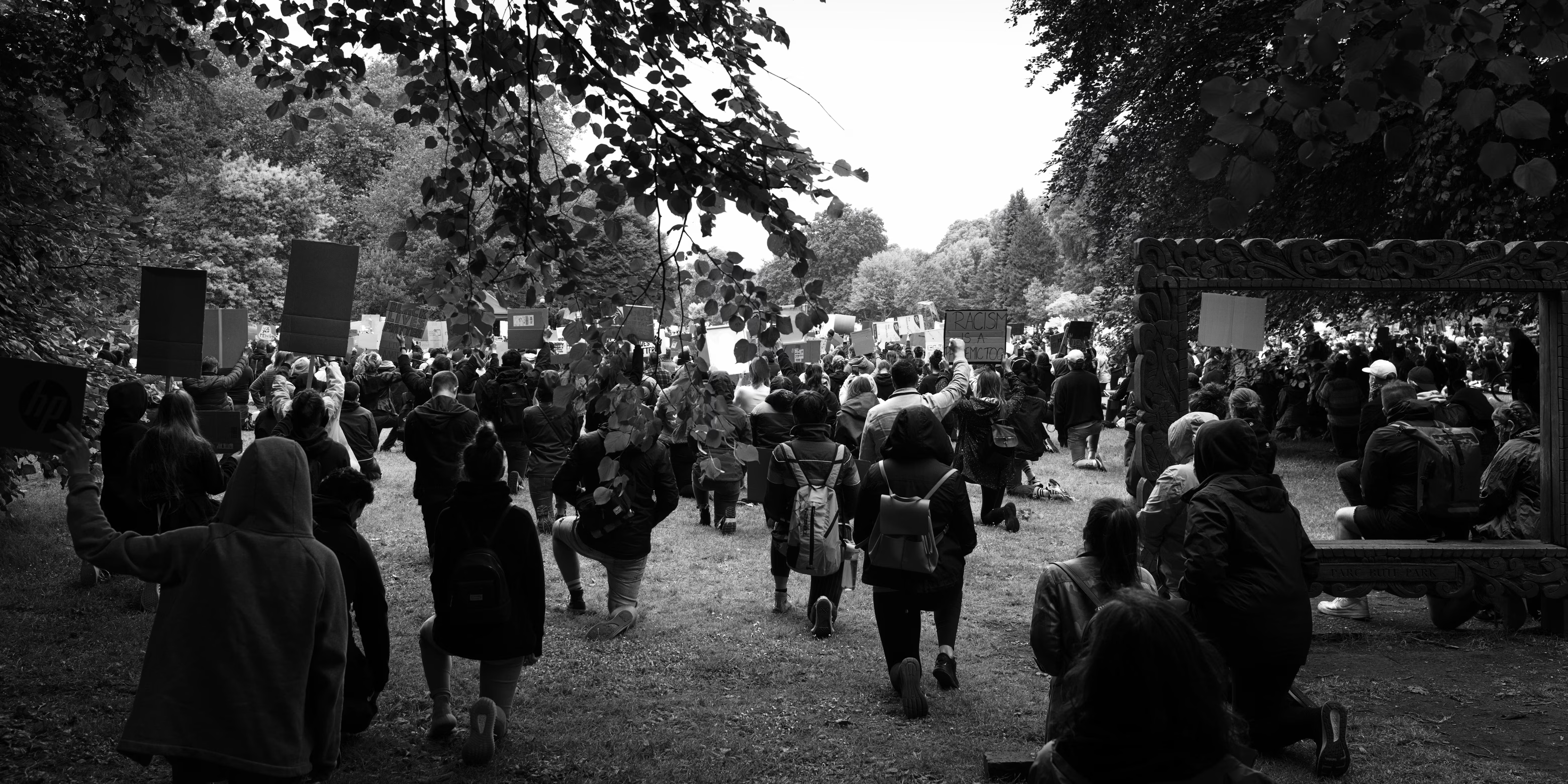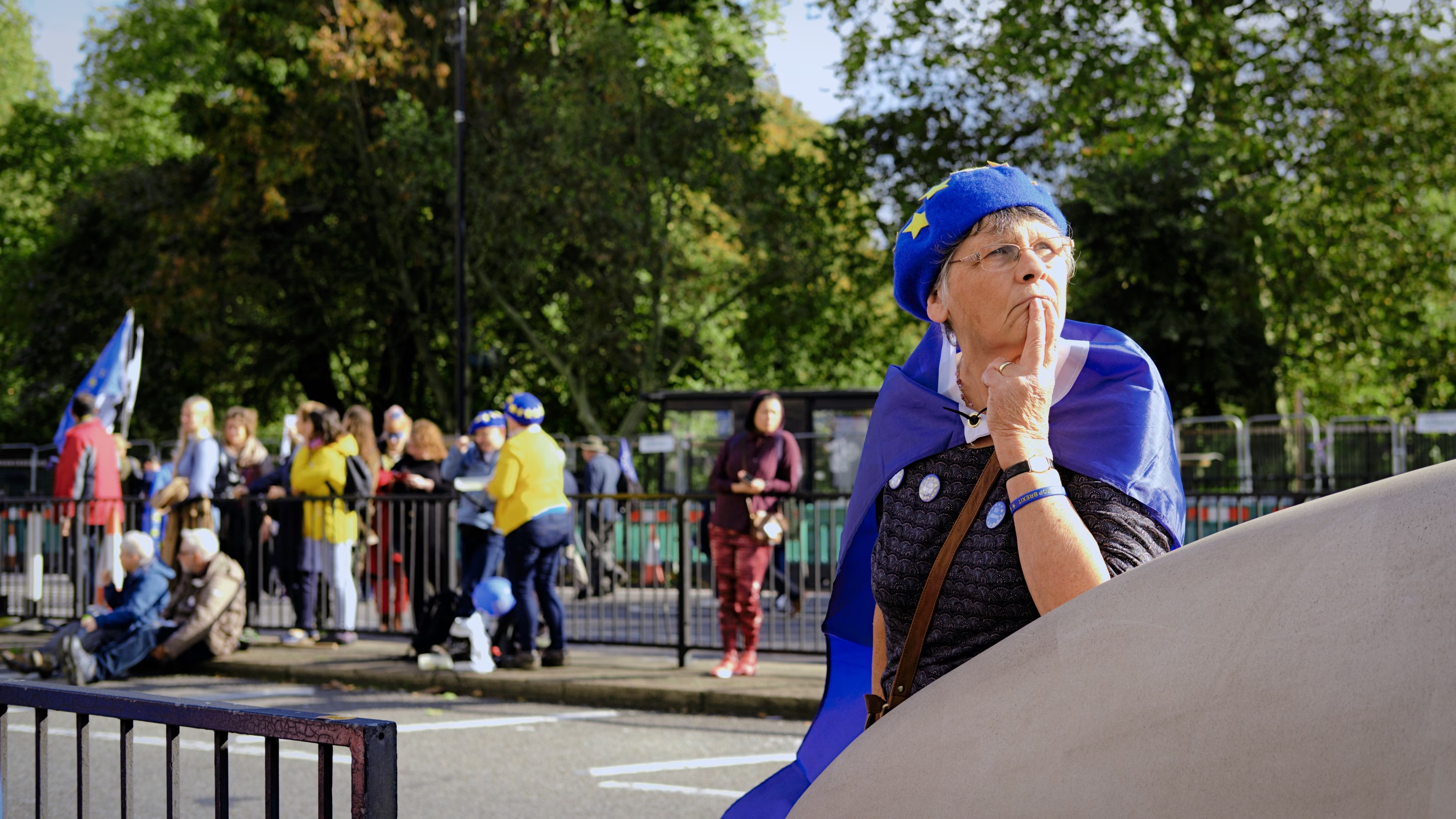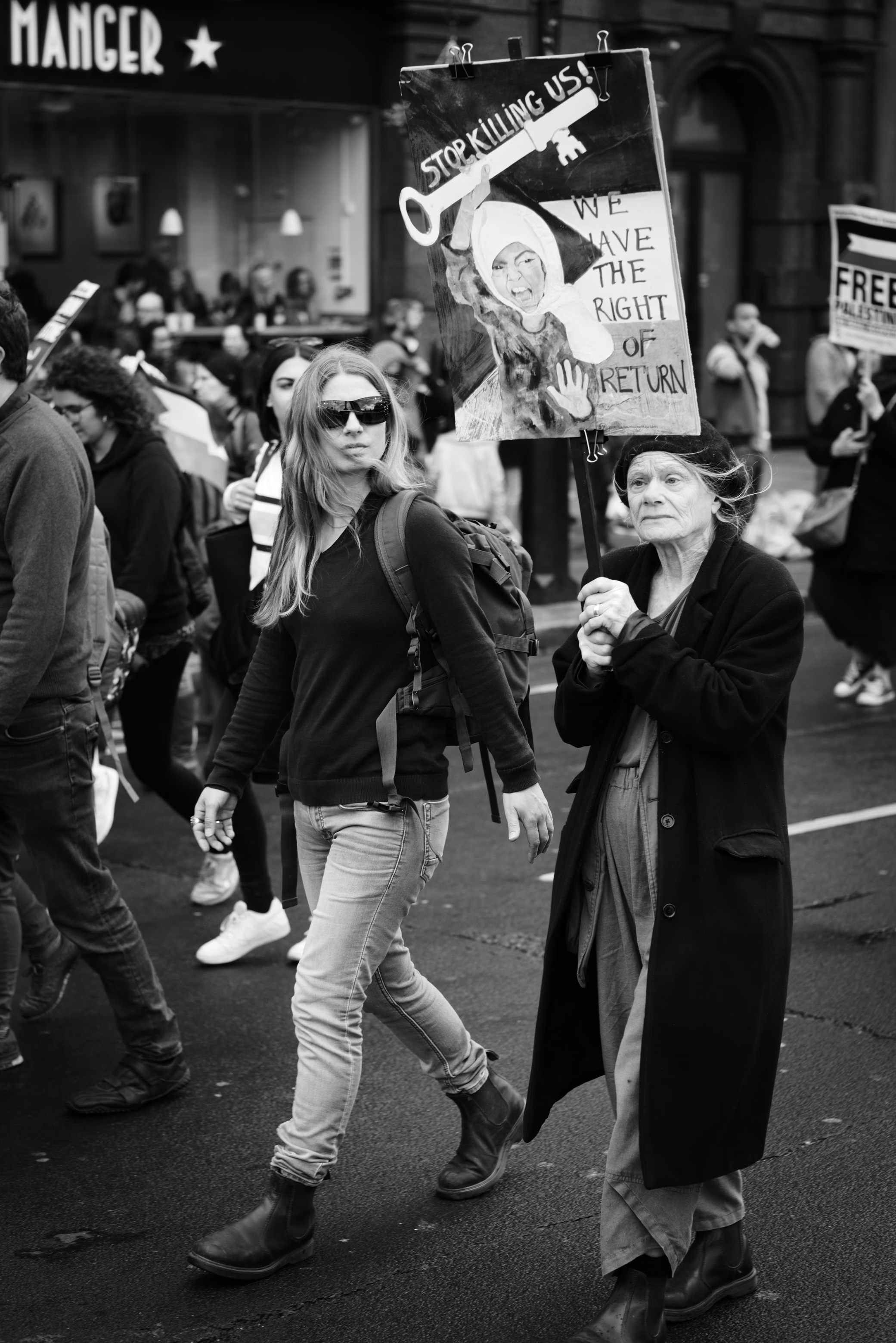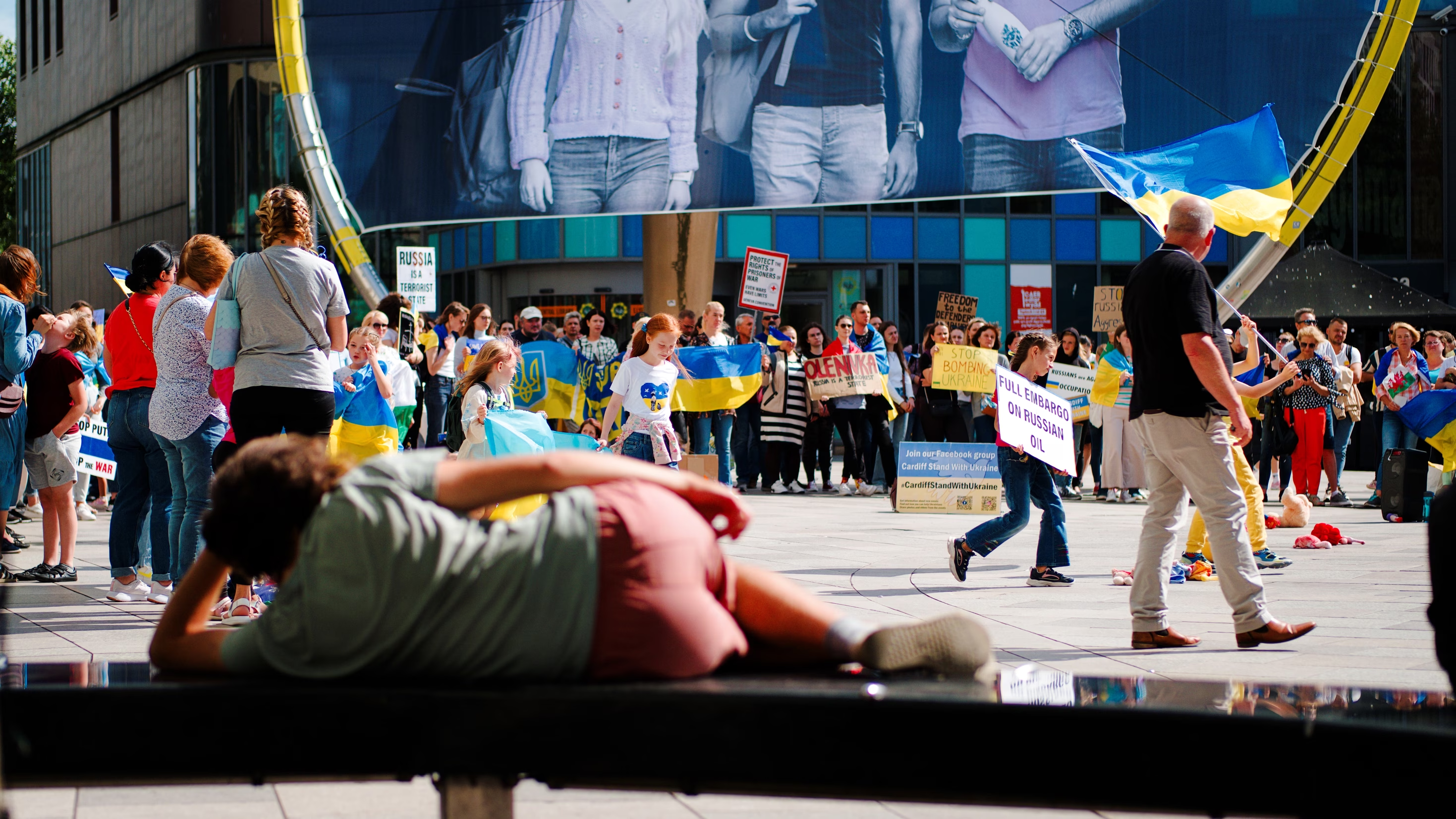
Street photography is my first love, the part of the art-form that finally grabbed my attention and drew me in after always losing interest in photography in the past — but I truthfully enjoy protest photography much more.
There's a ton of cross-over between them, capturing glimpses of people in their urban life. If you take the 'urban anthropology' view of street photography, protests represent a fundamentally human activity that's almost always visually interesting. If you take the journalistic or documentarian view of street photography, protests are important events to capture, either with a local history focus or in charting the changing attitudes and movements through time.
I'll blog more fully on street photography in the future, but my motivation, while borrowing from those two schools of thought, is much simpler. With both street and protest photography, my motivation is toward making visually interesting pictures of people doing stuff, whatever that may be. Protests are a rich environment in which to do that.
Protest photography is also generally easier than street photography. Any shyness or awkwardness over shooting people in the street invariably dissipates in an environment where people explicitly want to be seen, heard, and have their message amplified. The exceptions are few, amounting mostly to specific circumstances where people still need to retain their privacy (such as LGBT+ protests or acts of civil disobedience at climate protests) or where participation might embarrass, misrepresent, or humiliate someone (like when shooting someone being accosted by the police or shooting someone present at an anti-vaxx or similarly ridiculous event).
One of the traps I try to avoid is focusing too much on protest signs. In my view, photographs where protest signs are the subject have a strange sort of ephemeral appeal. They're visually interesting for a moment, but once seen, they immediately lose their impact. That's well-suited to the fleeting appeal one might vie for on social media, but it usually doesn't usually make for any lasting impression.
Signs themselves may be vital components of a visually interesting photograph — particularly when they're powerfully placed, well made, and not plastered in 'Socialist Worker' branding. On their own though, I try to avoid them, and rather pursue shots where signs add to the appeal of the picture rather than being the singular object of it.
When I Disagree
A quirk while attending protests is the division I keep in mind between being a participant and being a photographer. Most of the time, it barely needs consideration as I'm at protests I agree with. Most of the time, it's a bolster to my confidence if ever I feel strange running alongside a march or moving around awkwardly through a crowd.
On occasion, it's a boon too, a justification for me to remain as a photographer when protests I've supported have gone in a direction that doesn't appeal to me as a participant — like when speakers and participants outright advocate for communism, or toward supporting Corbyn, or rejecting my party or specific things that I find important.
The harder question for me is always when the opportunity comes up to shoot a protest I don't agree with. In my head, I maintain a notional commitment to the idea that as a photographer, I can very much attend them without supporting them. My hobby is in making visually interesting photographs, and there's ample opportunity to do so at protests for things and from movements I fundamentally disagree with.
I think the most soul-crushing of those were the anti-vaxx protests through the mid to late covid era. Some of the earlier ones were silly, with folks in faux HAZMAT suits stood silently holding up signs depicting and shouting aloud unscientific claims, but certainly visually interesting. Later on, they became more vociferous, more agitated, and came in the form of loud marches with lots of attendees. They were still visually interesting, but the appeal of my hobby was greatly reduced when surrounded by such loathsome people.
At protests for things I generally agree with, there's a wonderful sense of community that grows around a group of people in general alignment for a good cause. Protests are fun, an opportunity to talk with people with who you are likely to gel with, and an extraordinary way to come together and discuss things. To me, they impart a feeling of truly participating in society in a way most people rarely experience outside of election days.
At protests for things I don't agree with, I feel colder, more methodical. I am there purely as a photographer, like I'm at work doing a job rather than participating in anything important — all while being bombarded with views and slogans that I can't stand and while being surrounded by people I can't identify with at all. I'd also feel less safe at such protests if I weren't by my nature resilient to such folks.
More soul-crushing is the moment later on, editing my pictures looking for the best ones. I feel on those occasions like I'm cheating, as though stealing something I shouldn't be allowed to. Compounded with the sleazy feeling that comes along with sharing pictures of movements and protests signs I don't want to aid in espousing, it all amounts to something I rarely feel inspired to do.
My mode of shooting isn't primarily focused on the journalistic and documentarian side of things, but does borrow some elements of it. I have had my protest pictures used by news outlets in the past, and even looking back the mere ~10 years or so I've been shooting in anger I feel like I have a remarkable archive depicting how my city and the people in it have changed — along with the changing protest movements and issues through the years.
To that end, I do maintain that notion that I am open to shooting protests I disagree with, despite the issues that come with doing so. I might even embrace it more fully in the future should I shift more in that 'journalistic' direction, sharing a view of how such groups grow and behave. For now though, it's a very tentative practice from me, and one I enjoy vastly less.
What I Do and Don't Shoot
I'll cover off my 'rules' more fully in the future, but a subset of them apply specifically to protests. As with all my 'rules', they're more like guiding principles. There are always circumstances where breaking them makes sense, but sticking to them most of the time works well for me as a way to guide the direction my photography practice takes.
Likely the most obvious one for protest photography is that I try to never shoot someone obviously hiding their identity. Despite the inherently loud and public setting of a protest in which people generally want to be seen, there are times when folks make an obvious effort to hide their identity, for tons of reasons.
Anonymity can be an effective tool in protest, but the more pressing area is when individuals have a specific need to not be identified. An example would be at one of the counter-protests I attended opposite anti-drag protests outside my local library. A lot of participants there had an overriding need to remain anonymous and made obvious attempts to do so, for fear of being targeted or prematurely outed.
That's a rule I'll happily break in other circumstances however. I'm not generally inclined to avoid shooting those trying to avoid being identified at violent anti-lockdown protests, for example, nor those explicitly breaking the law (outside of the grey area of direct action at climate protests and other events).
I also generally try not to shoot children at protests. I'm not always entirely comfortable with children being at protests at all, when they're evidently too young to understand the issue they're apparently advocating. It sickens me when I see children at anti-vaxx protests for example, and even with protests for more benign movements — like the pro-Remain anti-Brexit protests — a little bit of that discomfort carries over for me. Still, past a certain age it certainly disappears, and even below it there are circumstances where children make for powerful and visually interesting photos.
The protests I support and agree with are likely no surprise to anyone who knows me. I'm very much left of centre and a staunch believer in the absolute supremacy of liberal democracy. That generally sees me supporting Remain/Rejoin marches, anti-Trump protests, Reclaim the Night, protests against police brutality, vigils for victims of hate crime, Black Lives Matter, pro-Ukraine protests, Pride, and various counter-protests against TERF/GC and other anti-LGBT protests.
In the past, I've also attended a ton of anti-war protests, but I generally avoid them nowadays. I'm not particularly any more or less opposed to war, but rather I can't take the organisations or the movements behind them seriously anymore. Rallying to oppose war was a noble pursuit in the era of Iraq, but later became a farce I can't associate myself with or give air to anymore. They appear now to oppose the right for liberal democratic states to exist peacefully and to defend themselves against military and terror attacks, in what looks very much like implicit support for militant authoritarian entities to wage war and commit atrocities as they please.
That same view extends to most of the protests over Israel and Gaza. I'd attended peace rallies for that cause regularly in the past, taking the view that Palestinian terror and rocketry and Israeli bombardment and periodic invasions were intolerable, that liberal democracy being non-negotiable meant that Palestinians in Gaza deserved the right to return to the democracy that Hamas usurped in their coup in 2007, and that Hamas should be extirpated from the region. That was what being pro-Palestine, pro-peace, and pro-democracy meant to me then, and it's what I believe now.
I think the realisation that others at those events didn't share my view dawned in 2014 during protests over the Israeli operation to cripple Hamas's rocketry capability in the wake of them having kidnapped and executed Israeli civilians and massively ramped up their rocket attacks. Perhaps the movement had changed or perhaps I had, but it became obvious to me that the movement wasn't serious, and wasn't seriously advocating for peace. Every conversation was warped by wild caricatures of Israel and the history of the region, and every suggestion toward peace had an implicit (or often explicit) acceptance of Hamas to it.
I stopped attending such protests after that, with a sole exception in 2016 where I happened upon a protest passing Trafalgar Square while I was visiting London for an exhibition. Rather than participate, I walked the length of the march backwards along the route they were taking, shooting casually as I went. From nowhere, a man stepped out of the crowd and tried to grab my camera. When I protested (albeit somewhat angrily), they bizarrely accused me of being from the CIA. An argument ensued, and as I started to get surrounded by very angry folks shouting at me, accusing me of being Jewish (as though such a thing is something to be accused of at all), and of being a spy, I walked back toward Trafalgar Square in a hurry.
My view that these weren't serious people and this wasn't a movement I wanted to be involved with anymore was already cemented by that point, so the incident made no real difference to me. It's still the only time anyone's ever gone for my camera or I've ever felt in danger at a protest — an oddity to consider given how I've counter-protested or been counter-protested by anti-vaxxers, the EDL, TERFs, anti-lockdowners, and all sorts of other unsavoury groups over the years. That it happened while the Intifada in Jerusalem was going on made it all the more odd.
Yesterday there was a large protest in London calling for a ceasefire in the region. At least 300,000 attended, and for weeks it's been touted as being likely to be huge. I thought about going as a photographer again, though definitely not as a participant given that I plainly don't support a ceasefire that leaves Hamas intact.
Any such inclination declined as I saw the shape of the many other protests over the last month take place. They were, like the protest yesterday, almost entirely peaceful, yet throughout I saw their signs and heard their chants, and recognised that nothing had changed — except, perhaps, for the unsavoury elements I no longer wish to be associated with being more explicit now than in the past.
If there were a protest specifically about how awfully Israel's military operation is going, taking incredibly long to achieve minor goals, so far failing to extirpate Hamas, and causing far too much collateral damage, I'd be there in a heartbeat — but that's a post for another time.


